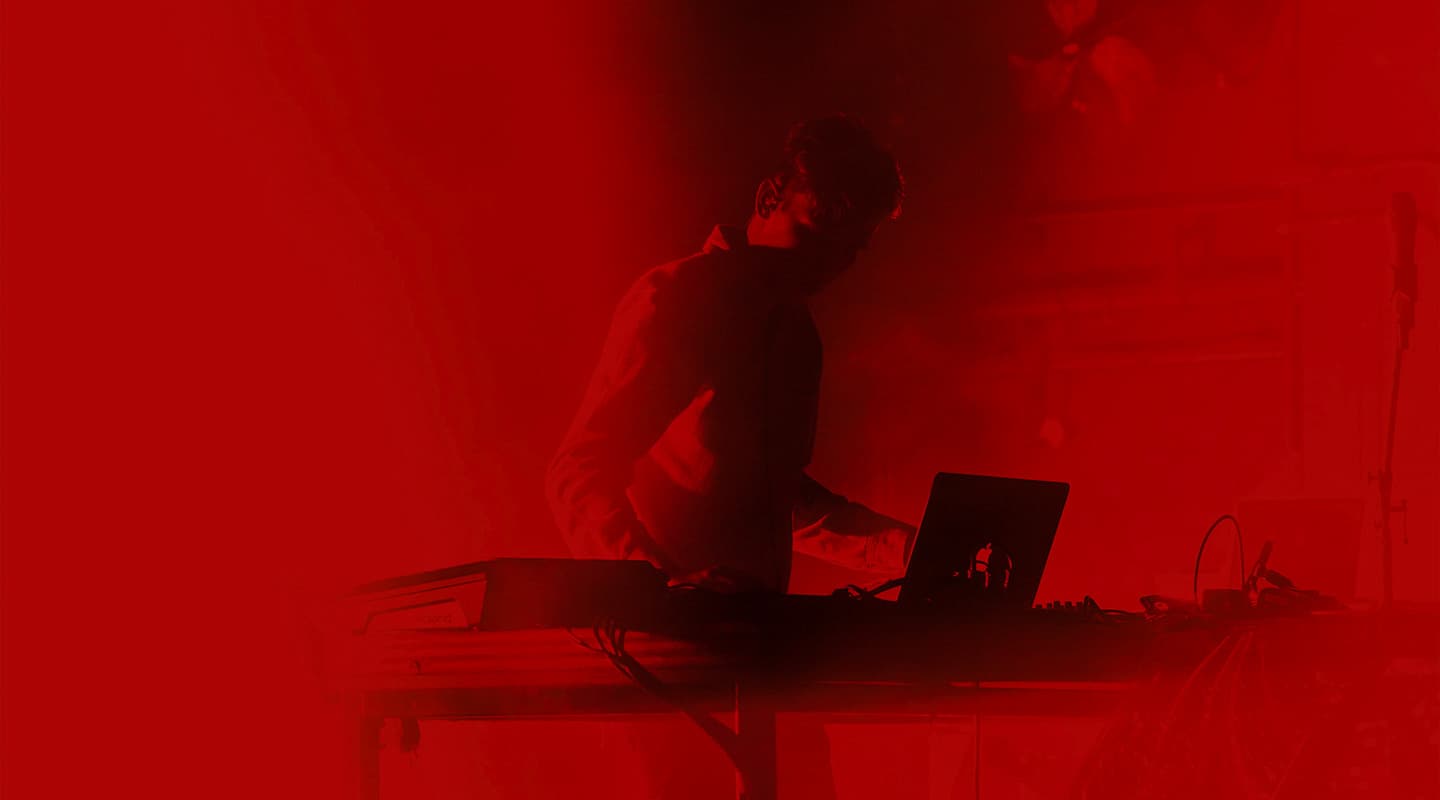
Doomsday Survival Kit
Three live performance experts share their deepest fears and how to avoid onstage meltdowns.
Formula One pit stops are pretty much where the race happens these days. Whether or not a team is gambling on a one-stop, two-stop or really trying to keep tyres fresh with a three-stop strategy is mostly what the BBC commentators bang on about for the entirety of the race.
It’s so predictable that the only differential between drivers is how many points of a second the pit crew faffs about in a pit stop. One second longer than normal is a total disaster. And if a tyre wrangler drops a nut, it’s race over and you may as well drive into the wall at the exit of pit lane.
Amazingly though, some musicians have no idea how long it would take them to get their show back on track if everything went pear-shaped. They’re gambling with their livelihoods every day. I’m talking about DJs, producers, bands, solo artists, anyone who uses a computer in their live setup. Even mix engineers to a certain extent, who are using computers to trigger events or add processing power to their rig. There’s a growing population of artists who run their entire show off one computer, completely unprepared for when it all goes bad.
So, let’s get redundant, baby!
To help save us from the inevitable doomsday scenarios, I talked to application specialist Jason ‘DJ Shine’ Spanu, a Canadian techno DJ who has toured the globe setting up systems and running playback for Nelly Furtado, Drake, Frank Ocean, Broken Bells, and many more artists; Lynden Gare, production manager for Flume’s Infinity Prism tour was also kind enough to fill us in on how Flume’s MIDI is managed; and Danny Harley, the one-man show that is The Kite String Tangle, walked me through his journey to figuring out how to get redundant. So if you’re walking the high-wire without a safety net, here’s some practical measure to land softly when things go to hell in a handbasket.
SHINING EXAMPLE
Technically speaking, Jason ‘DJ Shine’ Spanu is on the Broken Bells tour as we speak. Except he’s not. He’s at home, having sent a sub to cover for him on the last two weeks while he looked after a family member. He also got a call to set up an interactive iPad jamming station for a kids science event. It was a month’s worth of touring for a day’s work that came at exactly the right time.
Spanu’s life is anything but normal. Whether he’s on the road or not, he’s still the guy you call if you’ve got a problem, at any time of the night. As well as putting together and running the playback systems for touring bands, he also consults for others. “My phone rings at stupid times of the morning,” he explained. “And it’ll be the guys from Metric calling me or some other weirdo indie band asking, “How do you do the thing with the…?”
At which point he’s already put them on speakerphone and logged onto their desktop with TeamViewer. Which saves him yelling, ‘No, click that button!’ down the line thousands of times.
Spanu is a Toronto techno DJ who sort of fell into his current role as playback master. He moved in next door to where Nelly Furtado’s band rehearsed by fluke. The band got to know him as “the guy that used that f**ked up program Ableton Live,” and his roommate soon became their pot hookup. Spanu’s in with the band took a bit longer to eventuate — Furtado’s boyfriend also happened to be her DJ, thwarting any chance he had of cracking his way onstage with them.
So Spanu got on with making techno, and about three years later, they came back to him and asked him to show them that ‘f**ked up program’ again. Up to that point, they’d been using ProTools for playback, and the bass player/band leader was having trouble following Furtado when she wanted to stray outside of the bounds of a linear timeline. So the ability to time-stretch songs in one session, and loop and edit on the fly, had them in raptures. They were hooked, and asked him to join the circus at the height of her career in 2006. “On Day One we did every TV show on earth,” recalled Spanu. “All the different late night David Letterman-type shows. They had a variety show in Europe where they bring in all these international acts, and I realised I was the only one using Ableton, everyone else was using Digital Performer, ProTools or Logic. These days I don’t feel special anymore, they’re all playing Ableton.”
Spanu picked up Ableton at version five, and much of what he does stems from what he could do with markers back then. Depending on the job, Spanu switches between the Arrange mode and Session mode. If he’s DJ’ing, it’s Session mode, but if he’s just playing backing tracks, he sets up markers in the Arrange timeline at likely loop points, so he basically just has to hit a forward or back key at any time during the set. He uses the Arranger view because bands primarily know what note follows another, which part goes next, and the form generally stays the same. If he tried to get fancy by triggering sections in Session view, he’d likely stuff it up, or he’d have to program follow actions to progress to the next loop set… far too much hassle.
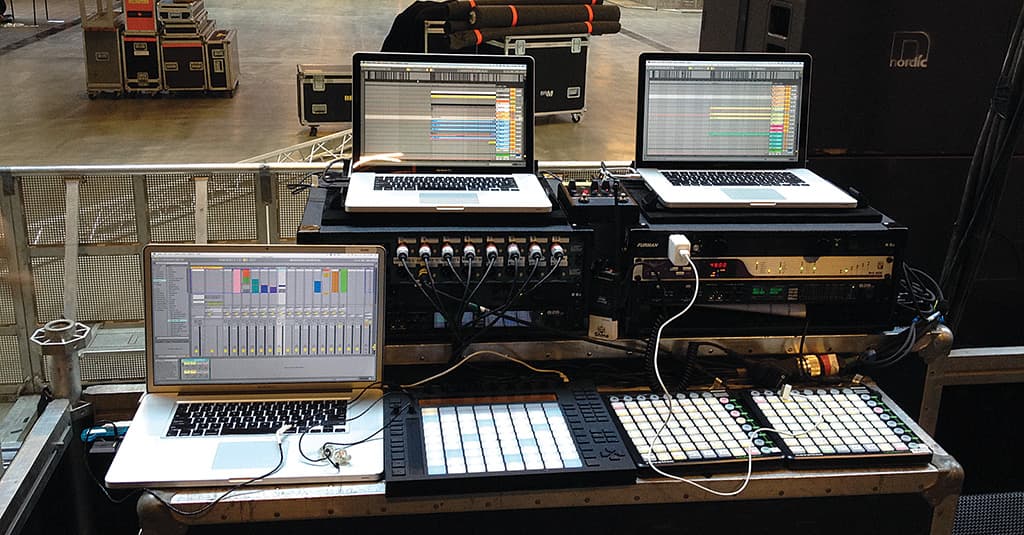

COMPUTERS ARE THE DEVIL
When Spanu first started out, the general consensus was that “computers were the devil, and you better hide that s**t. Don’t put it anywhere even near the stage!” Regardless of whether they made a dance album, and everyone knew where the sounds were really coming from, you wanted to look at the “hot chick, not the guy looking at a computer.” For some artists, like Frank Ocean, the whole band is under the stage, whether they’re tethered to a computer or not.
Artists tend to see Spanu more as ‘Wizard of Oz’ than DJ, so his ego has taken “more hits than it can handle”. It took years for him to finally make it up on stage with Furtado’s band. So when he got the opportunity, he carted his full DJ rig — two Novation Launchpads, an Ableton Push and two giant touchscreens — up onstage with him. Even then, for a show in Ibiza they still had a guy posing as the DJ onstage right next to him… At the end of the day, he gets paid the same whether he’s on stage or off.
For other bands, its clear what his role is. For instance, said Spanu, “Broken Bells came to me and said, ‘We need you to do this’. They’re not asking for ‘and be awesome’. They’ve got awesome covered.”
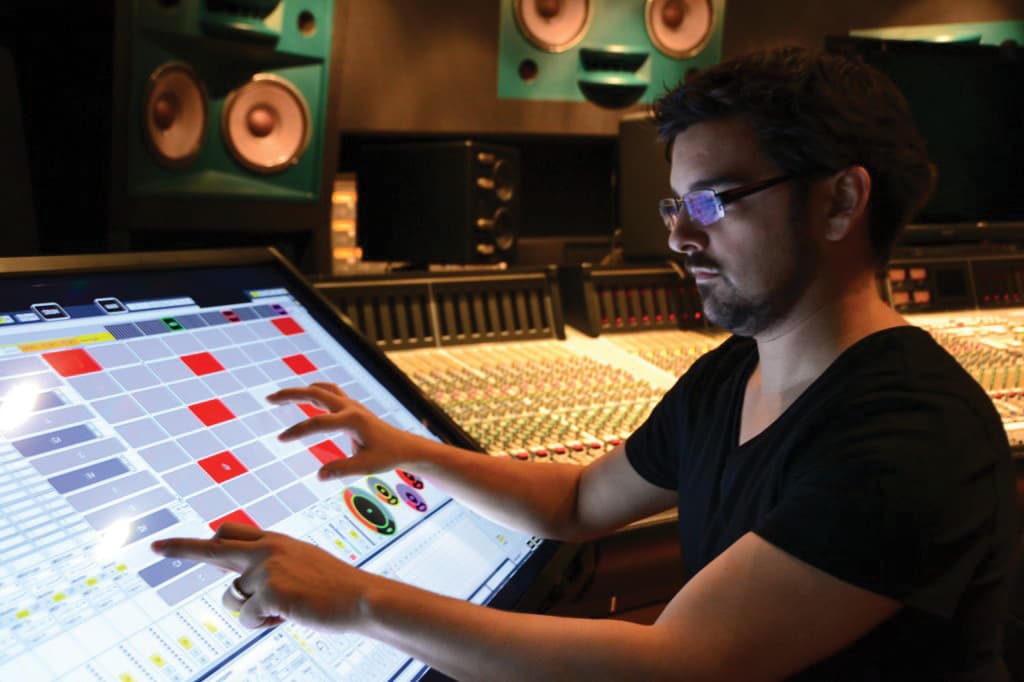

OCEANS APART
One of Spanu’s current clients is Frank Ocean, and the rig had to be scalable as required, but generally portable and fit for shipping. The rig comprises Ableton Live at its core, running on two MacBook Pros, with two portable MOTU Ultralite interfaces and a Radial SW8 eight-channel switcher between the two. He uses the seven-year old Ultralites because they fit in his hand, have 10 stereo line outputs — enough for any artist he’s working with — and are Firewire bus-powered. Which makes power supplies one less thing to worry about losing or going on the fritz.
When he first started buying gear for artists with a budget, he thought bigger would be better; more processing power would mean more stability. So he packed a MacPro tower into a foam-lined, touring rack so he could run 24 backing tracks. They went to play a show down in Mexico where the subs were plugged into the same generator supplying his computer. As soon as the sub kicked in he lost all power and his computer crashed. He soon realised it was dumb. “Who needs 24 tracks anyway,” said Spanu. “You might as well not show up.” Plus, when you’ve already got a 64-channel stage plot, no festival or TV show is going to give you 24 more lines to send to the computer guy.
From there it became, “What else can I erase from the equation?” Now the MacBook Pro runs itself and the interface from its internal battery. If everything else goes pear-shaped, he can still hit the next marker and get audio.
With eight tracks to play with, he usually divides his percussion up into frequency specific areas, so a stem of kicks, a stem of snares and other mid-heavy elements, and hi-hat loops on their own stem. Then it’s typically vocals and music separated onto their own stereo outputs, and two separate click tracks. One click goes to the drummer for the entire song, and the other one typically just gives the band a ‘1, 2, 3, 4’ count in. From there the drummer takes over, unless there’s a drum-less chorus breakdown or bridge.
Once he has the main markers in place, he then uses his experience to inform where other markers might be a good failsafe; places he knows he can loop if the artist decides to diverge into a 10-minute Kanye West-style monologue.
“Be aware that every time you put a marker down, you’re spending about a megabyte of pre-loading RAM,” said Spanu. “So when you’ve got 50 songs, averaging about 20 channels, and I put 10 markers into each song. Bang, I just spent some RAM. So I try to be a little sparing, but also not terrified about it, because it’s generally fine.”
Another thing he never does is upgrade straight away. “Live 8 came out and I didn’t even touch it,” said Spanu. “It was seven forever. When six came out I was like, five works, I’m not changing this.”
A WEB OF MIDI
Once the audio interfaces are synced up, there’s the issue of syncing MIDI. Depending on the artist, he might set up an eight I/O MIDI patchbay. If a band has keyboard controllers all over the stage, he’ll build a MIDI web that does all the control changes for the different synths from his computer. Spanu: “As soon as I hit Play on a new song, the sounds are all ready. And in the middle you can take the keyboard player’s sound and do another solo with an arpeggiator, and it becomes this massive ballet of MIDI.
“The next level is adding in video. That’s usually a word that scares a lot of people, but it’s pretty simple. All you’ve got to do is run some SMPTE timecode. Live doesn’t natively produce SMPTE, but you can just record the audio file of it, run it as a separate output and shoot that to the lighting console so everything comes together.”
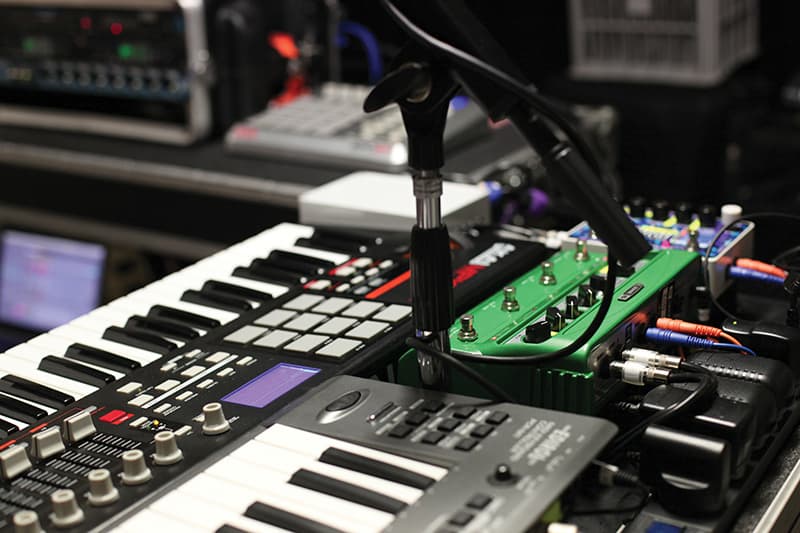
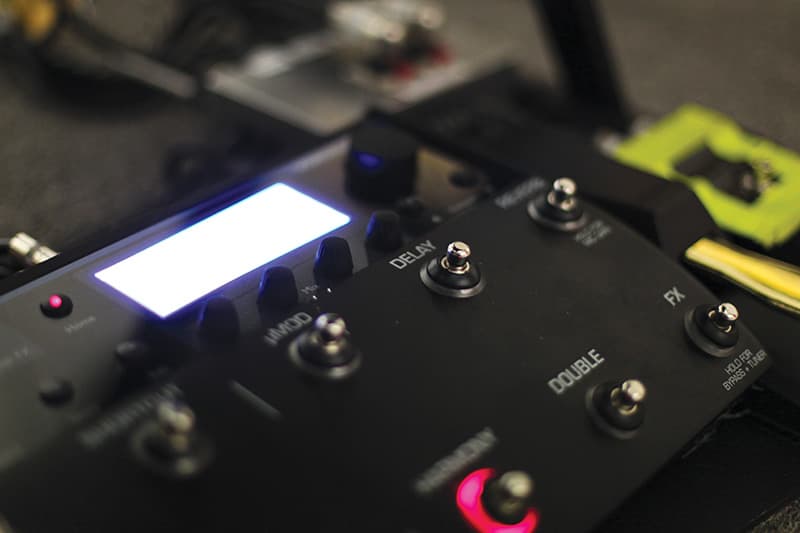

No tangles here — Harley’s rig is controlled by a Livid Ohm controller, Akai MPK49 keyboard and MPD pad controller, and Edirol keyboard. His effects chain includes a Line6 DL4 delay, an Electro Harmonix Cathedral reverb, and a TC Helicon Voicelive.
HITTING THE BUTTON
For Spanu, there’s no point in having redundancy if the changeover isn’t automated. Realistically, he says, if anything actually does go pear-shaped, it’s going to take him a second or two to notice, react and hit the ‘Oh s**t!’button. So he feeds one of the inputs to the Radial switcher with a separate VST test tone oscillator plug-in, set up in Ableton to continually emit tone whether he’s stopped a session or not. If the Radial stops seeing that tone at any time, it automatically switches to the inputs from the alternate audio interface.
The other issue is syncing his MIDI between the two sessions running on different computers. But rather than syncing MIDI timecode or having the computers talk to each other, he instead relies on control.
One of his associates, Matt Davis, who Spanu handed the Drake gig over to, programmed a mirrored Max 4 Live patch that allows one Launchpad to follow the other over MIDI. The Max patch waits to hear what button was pressed on the triggering Launchpad, tells the other Launchpad, and they both pass that information onto Live. It means that if the session stuffs up, the first Launchpad can still trigger cues to the second, allowing time for Spanu to shuffle over to the other system.
Spanu: “A simpler way of doing things is to get a MIDI splitter and a MIDI keyboard, map the names to certain notes, and by hitting that note it will split to both machines at the same time. You don’t want sync. Because sync relies on a relationship and if one of those things goes away, then what happens? There’s no point getting anal about phase, because at the time you have to switch between one and the other, whether or not it was on by a frog hair is not going to make any difference.
“I made a bunch of how-to videos with the Metric guys, and one of them was literally walking up to the computer and yanking out the Firewire cable. He didn’t even notice it switch, it was amazing.”
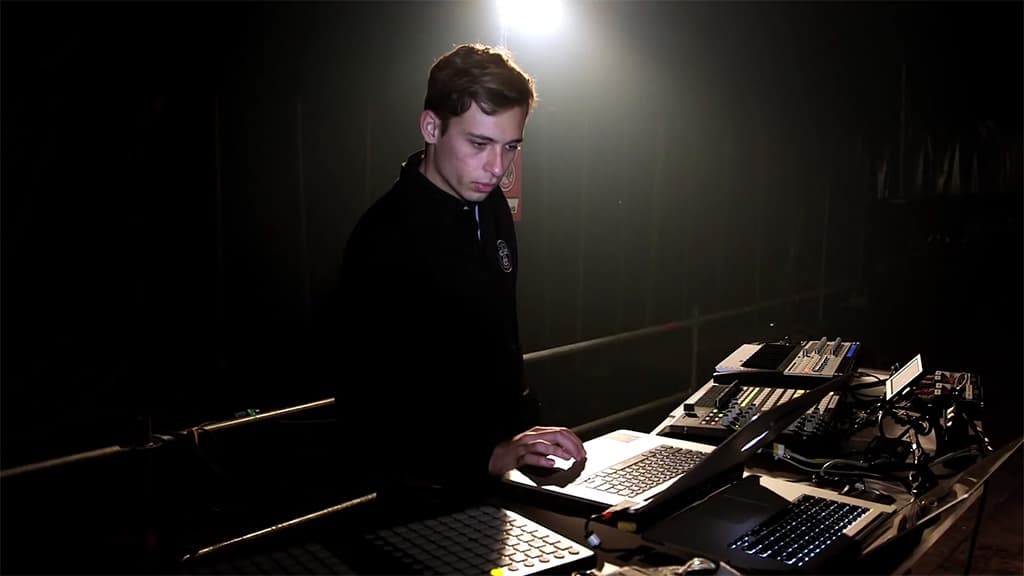
TOUCHUP ON DEVICES
Spanu also DJs on stage for Toronto R’n’B artist Julie Black. He has a lot of fun with, four iPads running a TouchOSC patch, Lemur and TouchAble. But his problem is always the network. “It’s the radiation soup of signals floating around us all the time,” reckons Spanu. “Cell phones, radioactive crap… Fukushima. Any of those things interfere with my ability to make a network a foot away, even via a simple connection — it’s stupid! I’ve got 100,000 people in front of me, and I can’t do any of it.
“The new version, TouchAble 3, will finally have a connection from the phone jack. So I intend to split the workload up between things I know are simple and stable, and things that are awesome and fun. TouchAble lets me adjust every parameter on the fly really quickly without messing with a mouse. But it’s all going through digital wonky wi-fi so it may go out at any moment. If I put a filter effect on each of the vocal tracks and control it from my iPad it better be a very stable connection, because if I pull it all down then go back up, and it doesn’t go back up… disaster!
“It happened to me the other day in a small theatre with 400 people. Everything was fine and all of a sudden the connection went bad. It’s all fresh gear, a new iPad Mini, but something is freaking it out. In-between sets I had to reprogram it all. Luckily, I always bring a hard-patched MIDI device with me — something with knobs. If I was hiding behind a curtain I wouldn’t care. Just hit spacebar and f**k off, but on stage I want to interact and not be the guy faking it. I’m of the generation that doesn’t do jumping jacks when I perform.
“I generate my own network, because generally you need a really high-powered transmitter to rise above everything. The problem is all those phones’ default channel is the same channel I’m using, so there’s all this crosstalk and inter-modulation frequencies shooting around. And if I go to a lower channel it doesn’t have enough power. The wi-fi world is a pain in the arse.
“Generally I’ll do things like mixing, sends, throws, and any automation that I want to have control over. I’m not doing too much, but if I want it, I know it’s there. I’ve simplified my interface because we’re all smart, but when something goes wrong on stage our IQs drop to single figures. you’ve got to build your system to be run by a baby who just got ran over.”
64-BIT, BUT NOT 24
When most people start using computers live, they’re petrified to do anything more than hit the space bar. “It’s shut up and hit Play, because everyone is still terrified and thinking we’re running it on a Commodore 64.”
But more than user error, the times Spanu has seen everything go wrong is when artists ask too much of a system. Like running 118 tracks, or insisting the tracks have to be in 24-bit. “I’m like dude, we’re not performing at a DVD authoring factory,” laughed Spanu. “We’re out in this gross s**thole and I’m one of 60 tracks on stage. It doesn’t matter if I don’t have the depth of a 24-bit dynamic range. Let’s pull back all those numbers and be cool.”
Other times, he just can’t explain what’s wrong. The Broken Bells session is pretty elaborate, they have four keyboards on stage all running internal Ableton soft synths in the one session, with lots of tracks playing as well. But they’re running it at 64-bit with 16GB of RAM, on solid state drives, using UA Apollo Quad interfaces with 16 outputs. The system is completely stable, but for some reason, one file is causing the whole session to “eat a dick in one spot that we can never fix no matter what we do.”
Other than the odd voodoo moment, it’s mostly “buffer overruns or disk overload messages where I’m trying to pull too many things at once, or fighting for RAM allocation with drivers,” said Spanu. “That’s why I tend to stick with what works. I don’t know what a Focusrite Saffire will add into my equation until I’ve had a couple of weeks personal experience running the thing.
“The last time I did a massive upgrade, I stayed home for a week and just left everything running for 12 hours. I looped this massive two-hour show six times while another machine was recording what was happening. Once it passed that test, then it was alright to go out.”
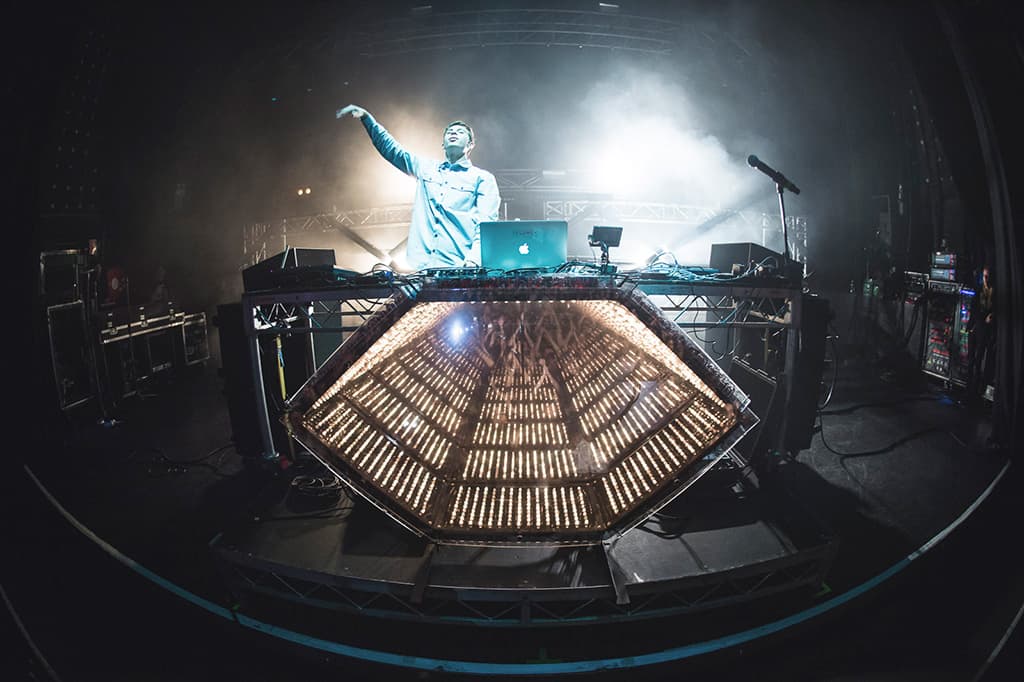
AN APPLE A DAY
Spanu always has the artists buy the kit needed to run the show, rather than operating on a loan-hire system. It’s part of the redundancy package; he doesn’t want the whole show to go down even if he decides to call it quits. But before he buys anything, he picks through what they already own, because “a lot of these bands have a courtyard worth of crap you could put together,” said Spanu. “Once you’ve picked up random cases and other bits and pieces, you budget it out and let them go to town.
“I like to buy three of everything in case one goes down, so it’s a redundant system. I try to roll like an Apple store as well and bring a couple of all the connectors you need. I also try to keep my spare systems small enough to carry them on. I don’t mind shipping the big rig, but if the plane crashes and I get out, I’m grabbing that bag and we’ve still got a show. I’m that stealth dude who ninjas around airports. I take up like nine bins, and put a 60-pound bag in the overhead — if that falls out it will kill someone.
“Everyone else can just get a guitar and plug it in, or a keyboard and find some stupid sound and play it and you’ve got a show. But if the computer guy has lost his Mr. Wizard box, then you’re crying.”
COOL IT
Spanu: “There’s been four times when I’ve had issues running Ableton and all four times were to do with one issue. I was on this big tour with Nelly and it was heat. Heat is a bitch. Computers do not like heat!
“We played in a hot steamy Parisian club and towards the end of the show the computer just went to grey screen. It was the first time I’d hit the ‘Oh s**t!’ button in two years.
“The next time was in New Jersey, again in a hot steamy club. I was like, “Yo Apple Store, fix my s**t, Nelly Furtado, let’s go right?’ And then the next time was in Denver. Same thing, hot sweaty club and by now someone else is like, ‘Dude, it’s the heat!’
“The last gig we had was in Las Vegas at 8pm, which means soundcheck at four in the blistering sun. We got industrial-strength fans and I duct-taped them to my computer at both ends and turned them to stun. Towards the end, one of them died. By then it was like, I’m just gonna use laptops and keep it simple.”
Why laptops? Not because they don’t get affected by heat, but because they’re mobile. You can move them to a cooler spot if you really need to. He’s seen people use computer gel packs to cool down their machines before, but Spanu puts beating the heat down to two things — circulation and decoupling. To get his computer off the deck, and keep air all around it, he wads up a few gaffer tape balls and sits his laptop on those.
The tape balls also help minimise vibrations getting at your hard drive (less important these days with SSDs) and your audio interface connections. He was DJ’ing for hip hop artist Socrates one day, and when the first beat dropped at full volume, the computer crashed and the audio interface got stuck on the last number it was making… at full volume.
Thinking about redundancy amounts mostly to common sense, before getting on stage. Because when you’re up there, if anything goes wrong, the only thing you’ll be able to do is hit the ‘Oh s**t’ button and hope for the best. As Spanu puts it: “You’ve really got to plan for the worst and expect the best. Somewhere in the middle you’ll have a good show.”
















RESPONSES